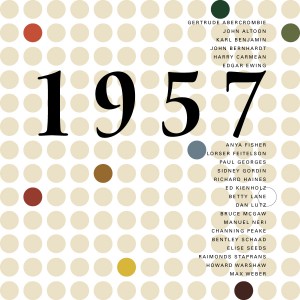1957, 2007
« WRITING | Posted on 05/18/2009 10:29 pm by admin Elvis bought Graceland and a young John Lennon met a young Paul McCartney. Dwight Eisenhower started his second term as President and a young senator named John F. Kennedy made his first television appearance. The children read The Cat in the Hat, and the twenty-somethings read Jack Kerouac’s On the Road. The Russians launched Sputnik, and Whamo launched the Pluto Platter - the forerunner to the frisbee. Walter Hopps and Ed Kienholz opened Ferus Gallery in Los Angeles and Leo Castelli opened his gallery in New York. It all happened in 1957. It was a pivotal year.
Elvis bought Graceland and a young John Lennon met a young Paul McCartney. Dwight Eisenhower started his second term as President and a young senator named John F. Kennedy made his first television appearance. The children read The Cat in the Hat, and the twenty-somethings read Jack Kerouac’s On the Road. The Russians launched Sputnik, and Whamo launched the Pluto Platter - the forerunner to the frisbee. Walter Hopps and Ed Kienholz opened Ferus Gallery in Los Angeles and Leo Castelli opened his gallery in New York. It all happened in 1957. It was a pivotal year.
In American art, modernism had finally been accepted to a significant degree. Skirmishes remained, but the war was over. Schools had long since been classified and Masters had been identified. The faculties of America’s art schools were flush with modernists of all stripes. Conservative patrons were buying the formerly difficult works of Cubists, Futurists, Constructivists, and Expressionists. (Only the Expressionist art labeled “social realist” had been sacrificed in the Red Scare of the early 1950s.)
While the Abstract Expressionist schools in both New York and San Francisco had been the last of the major schools to appear on the scene, they were firmly entrenched by 1957. Critics Harold Rosenberg and Clement Greenberg trumpeted Ab-Ex painting as the most sophisticated and important contribution to Modern art yet, but, there were already fissures running deep through their orthodoxies.
In 1950, San Francisco abstract painter, David Park, entered a reductive painting of kids on bicycles into the San Francisco Art Association Annual and won a prize. While other painters felt that Park had “lost his nerve,” the impulse to return to the figure proved compelling nevertheless. Even as large numbers continued to paint purely abstract (or non-objective) paintings, a small group of artists began to treat the figure regularly using the gestural brushwork and thick impasto of the Abstract Expressionists. In 1957, these artists became known together as the Bay Area Figurative painters in an exhibition curated by Paul Mills at the Oakland Art Museum.
In Los Angeles, Cubism was at its apex. Howard Warshaw, Rico Lebrun, Channing Peake, William Brice, Richard Haines, Edgar Ewing, Sueo Serisawa, Francis De Erdely, and Bentley Schaad were all pursuing Cubist experiments. As one dealer from the period shared with me, “They were so civilized. Not like the generation that came next.” If the old guard represented culture, the new guard represented the counter culture.
On the East Coast, Leo Castelli opened a gallery devoted to the Abstract Expressionists, but he would soon show Robert Rauschenberg and Jasper Johns - two artists whose works questioned the distinction between High and Low art. Castelli later became the top dealer of Pop art on the East Coast.
On the West Coast, Ferus Gallery opened its first exhibition in 1957. Titled, “Objects on the New Landscape Demanding of the Eye,” the exhibit focused on the Beats’ critique of consumer culture and the growing sense that a new era in art was dawning. Four years later, the gallery would debut Andy Warhol’s “Soup Cans.”
- Jeremy Tessmer